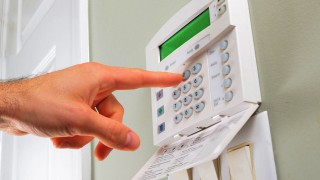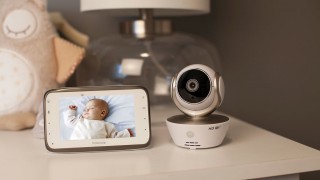3 best IP camera with Wi-Fi
- Reviews: 1
- Views: 902

Appointment
Traditionally, IP cameras refers to the device category, which in its algorithm the data link converts them to an analog signal, and gives it as it is — digitally. But that's not their main feature. The IP prefix in the name indicates that data can be transferred directly or with compression on the digital channels that use the IP Protocol.
The lack of data is converted to an analog signal opens up great opportunities for use. In particular, it is possible to use large resolution and any frame rate. Naturally, the IP camera can be used remotely, if necessary, scaling the video surveillance system.
The advantages and disadvantages of IP cameras
First, the advantages. Since the image of the receipt data from the image sensor to receive the output remains digital for adjusting picture quality you can use intelligent digital algorithms. That is, even the camera itself can be finely tuned for any conditions of shooting. The figure also allowed to get rid of unnecessary overhead of signal conversion from matrix to analog and then back to display on the monitor. The advantages include the ability to compress the digital signal, thus saving space on your media and faster to transmit it over the network.
And finally — the opportunity to work with a camera from any corner of world with Internet access. With the advantages, perhaps, everything.
Now a little about the disadvantages. IP camera — a network device having a private IP address means access from the outside. Therefore, if the wrong security settings information received from the cameras may become available to third parties. That is, the barrier to entry for the average user is significantly increased and necessitates at least a basic knowledge on configuring secure access. Further, individual IP camera is much more expensive than its analog counterpart. However, the scale of the surround surveillance system, taking into account future expansion, layout, and all necessary equipment, IP cameras in the complex cheaper. And finally, some configurations of video surveillance systems involve the compression of video data for transmission, which imposes restrictions on the equipment used.
The functions and features
To start, first, with PoE — Power over Ethernet. That is, the methods of supplying current to devices through a twisted pair in networks such as Ethernet. If the camera supports PoE, and a model of the network allows it, the device gets almost complete autonomy. To connect nothing else, you just connect the cable.
The user may also need support WDR or HDR – the dynamic range. They allow the camera to adjust the levels of black and white frames with a large difference in illumination.
From additional conveniences it is possible to allocate built-in support for cloud services to save video directly to a remote hosting. This is useful for cameras with motion sensor that allows you to record data only when in "field of vision" device hits a moving object.
And, of course, support wireless network. It's just a plus and a minus IP camera. Positive thing is that at small distances it is possible to deploy a network of cameras on a single router without cables and awkward connections. The negative side is that autonomy requires sacrifice, and in our case — supply. Cable is not, therefore, to have power either from the battery, which is inconvenient, or from the Central network.
Infrared light allows shooting in the dark. The actual option for around the clock surveillance of protected objects. Specifications manufacturers usually specify the illumination range in meters. You can choose the model that is to suit your needs.
The light sensor is closely associated with IR illumination. He is part of a system of automatic transition in the modes "day/night". The sensor is triggered at a certain light level, turning the camera mode to "night" and IR illumination, or Vice versa.
As for motion sensor, this function helps to save time and the cost of storing video data. To apply this equipment is only on objects and in areas with low permeability: industrial workshop, warehouse, yard of a private home, a room in the apartment. For static picture, the camera just stares, not producing the entry. As soon as you start the movement, immediately starts recording, and the information stored on the specified media. Sometimes it's very convenient.
Management lens and connected to a smartphone
Since the camera we have the IP, then there is always the access from the network. If the developer is not bothered about creation of convenient applications to manage, it is possible to access the camera via a standard browser of the smartphone. In fact, now there are plenty of universal apps, which allow you to connect to any cameras, knowing their address, login and password.
But to control the lens, changing the focal length, should be able the camera itself. Besides, time meant remote control, the lens must be motorized and, therefore, have even further food. Such cameras are more expensive and can be used on particular objects. For example, in Parking lots, when you need to see the license plate of the car in the distance.
Microphone
Pretty rare option, as most surveillance systems are not in demand. Often enough just the image. Sound more relevant to the various checkpoints when you need to ask the password, the purpose of the visit or something.
Vandalism protection
Despite the fact that many villains are knowledgeable about how the IP camera, and you know what they write video somewhere on the server, and to this day try to break. Specially for such people invented anti-vandal camera with a shock resistant casing.
Interestingly, this camera is quite capable to withstand several strong blows with a hammer and, even then, can continue to record your evidence against the bully. These models are quite expensive and are installed in areas of high terrain without human protection, for example, in dwelling houses.
Popular IP camera with Wi-Fi
We have selected a few popular camera models with features and prices. Perhaps someone it will be useful in the selection.
Dummy camera
Sometimes a semblance of safety did no worse than the security. Dummy cameras can be used as a preventive measure. On Aliexpress you can find models from 300 rubles, and even blinking for the kind of LEDs. Interestingly, this approach very often works and allows to reduce the number of offences without any extra costs.
Inexpensive camera for 4000 rubles. At the same time, it is equipped with a rotary device, built-in speaker and microphone. Perfect for home or office use. You can also use the camera as a baby video monitor by placing it on the table or ceiling. In night mode, the device "sees" on 12 meters. The matrix size is a quarter of an inch at a resolution of 1280×720. Working with the cloud directly, the camera does not know how, but you can connect it to your smartphone, computer or record videos on a flash drive. Can rotate both horizontally and vertically.
Price: ₽ 990 3
2. Zodikam 3951-WPTZ
This camera is suitable for video surveillance on the street, for example, in a private home. However in particularly cold regions to use it will not work — the stated minimum temperature is only -30ºS. Night the camera finishes off the rays of infrared light by 15-20 m. the Matrix has a size in a third of an inch. And the maximum resolution is 1280×720. To buy the device for 12,000 rubles.
Price: ₽ 12 000
3. Hiwatch DS-I114W
Home camera for 7000 rubles. Has a fixed lens with a focal length of 2.8 mm. Max resolution 1280×720 in the matrix, the size of a quarter of an inch. The camera's versatile — can use wired and wireless network. Data is written to a USB flash drive with capacity up to 128 MB. It should be noted PoE that is present in the model.
Price: ₽ 7 250
How to choose IP camera with Wi-Fi for home
IP camera is one of the types of devices which, because of its complexity, as well as a huge selection of versions, has an extensive list of parameters and characteristics. Even an experienced user is not always easy to immediately recognize that the model before them what it can do. Therefore, we now analyze in detail which features of IP cameras you need to pay attention when choosing.
Important characteristics, which will depend on the quality of the pictures, only two: the matrix and the lens. First, a little about matrices. If just, this set of photosensitive elements, which, when the light strikes them they generate an electrical signal, and then forming the overall picture. Physically, it's a small mesh size from 1/4 to 2/3 inch.
Each cell represents a single photosensitive element and a set of electronic components. And such cells can be several million, depending on the resolution of the camera. Sensor size matters — the larger the area, the more light it picks up and has less interference due to less dense placement of pixels. Do not forget about the camera resolution. The number of cells — this is the permission that can be specified in the specifications, for example, 2592×1944. The higher the value, the more detailed the picture.
Different matrix and the type of reading. CCD-matrix read data sequentially, line by line, pixel by pixel. CMOS-matrix reads arbitrarily. It is logical that CMOS runs much faster, which is very important for cameras with high resolution and frame rate. In General, the market for modern videowidget you are unlikely to meet CCD-matrix. Most manufacturers completely switched to CMOS. Will only have to determine the best ratio of resolution and size. But there is another parameter — light sensitivity. If your fingers — that this is the minimum level of illumination sufficient to produce an image on the matrix. In General, this parameter may be offset used by the switching mechanisms in the modes "day/night", also the use of infrared light. It should be noted that the sensitivity is a relative parameter, which is best defined by comparing image from different cameras. The fact that the specifications can be specified, taking into account different conditions — light level, focal length, lens and other things.
The lenses are very simple. Wide angle can cover a large area. This option is suitable for outdoor surveillance applications. The angle affected by the focal length. That is, the distance from the lens center to the sensor. The shorter the focal length, the wider the angle. On most budget IP cameras the focal length is fixed. More expensive models may have a motorized lens that can change focal length and, accordingly, to adjust the picture. In General, the rule is simple: we need a detailed and clear picture — select a narrow viewing angle, an important large area coverage is wide.
Also pay attention to the material from which lenses are made. There are two common variants: plastic and glass.









Your opinion - will be useful to all!